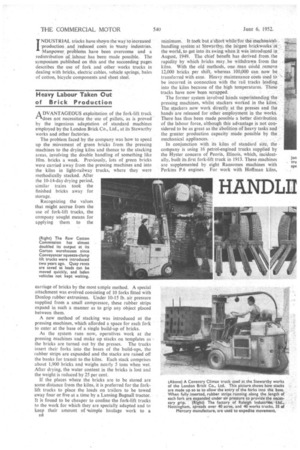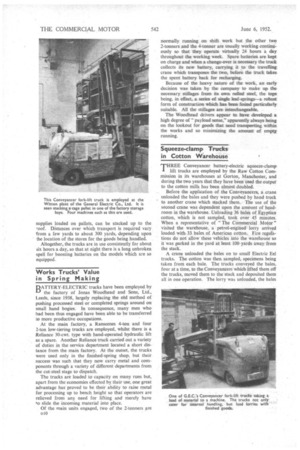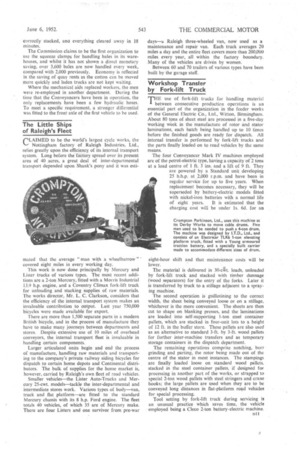PROBLEMS SOLVED IN MANY INDUSTRIES
Page 49

Page 48

Page 50

Page 51

If you've noticed an error in this article please click here to report it so we can fix it.
INDUSTRIAL trticks have shown the way to increased 'production and reduced costs in /nany industries. Manpower, prollems have been overcome and a redistribution of labour has been made possible. The symposium published on this and the succeeding pages describes the use of fork and other works trucks in dealing with bricks, electric cables, vehicle springs, bales
of cotton, bicycle components and sheet steel. .
Heavy Labour Taken Out of Brick Production
DVANTAGEOUS exploitation of the fork-lift truck 4—kdoes not necessitate the use of pallets, as is proved by the ingenious adaptation of standard machines employed by the London Brick Co., Ltd., at its Stewartby works and other factories.
The problem faced by the company was how to speed up the movement of green bricks from the pressing machines to the drying kilns and thence to the stacking areas, involving the double handling of something like 10m. bricks a week. Previously, lots of green bricks were carried away from the pressing machines and into the kilns in light-railway trucks, where they were methodically stacked. After the 10-14-day drying period, similar trains took the finished bricks away for storage.
Recognizing the values that might accrue from the use of fork-lift trucks, the company sought means for applying them to the carriage of bricks by the most simple method. A special attachment was evolved consisting of 10 forks fitted with Dunlop rubber extrusions. Under 10-15 lb. air pressure supplied from a small compressor, these rubber strips expand in such a manner as to grip any object placed between them.
A new method of stacking was introduced at the pressing machines, which afforded a space for each fork to enter at the base of a single build-up of bricks.
As the system runs now, operatives work at the pressing machines and make up stacks on templates as the bricks are turned out by the presses. The trucks insert their forks into the bases of the build-ups, the rubber strips are expanded and the stacks are raised off the banks for transit to the kilns. Each stack comprises about 1,900 bricks and weighs nearly 5 tons when wet. After drying, the water content in the bricks is lost and the weight is reduced by 25 per cent.
If the places where the bricks are to be stored are some distance from the kilns, it is preferred for. the forklift trucks to place the loads on trailers to be towed away four or five at a time by a Lansing Bagnall tractor. It is found to be cheaper to confine the fork-lift trucks to the work for which they are specially adapted and to keep their amount of -csimple haulage work to a ag minimum. It took but a'short whileifol the mechanicalhandling system at Stewartby, the largest brickworks in the world, to get into its swing when it was introduced in August, 1949. The chief benefit has derived from the rapidity by which bricks may be withdrawn from the kilns. With the old methods, one Man could remove 12,000 bricks per shift, whereas 100,000 can now be transferred with ease. Heavy maintenance costs used to be incurred in connection with the 'rail tracks leading into the kilns because of the high temperatures. These tracks have now been scrapped.
The former system involved hands superintending the pressing machines, whilst stackers worked in the kilns. The stackers now work directly at the presses and the hands are released for other employment in the works. There has thus been made possible a better distribution of the labour force, although this advantage is not considered to be as great as the abolition of heavy tasks and the greater production capacity 'made possible by the mechanical appliances.
In conjunction with, its kilns of standard size, the company is using 16 petrol-engined trucks supplied by the Hyster concern of Peoria, Illinois, which, incident ally, built its first fork-lift truck in 1913. These machines are supplemented by eight Ransomes machines with Perkins P.6 engines. For work with Hoffman kilns, which are smaller, about 30 Coventry Climax appliances are used.
The average fuel consumption is about 10 gallons per nine-hour shift with the Hysters and half this amount for the Ransomes. A valued feature of the American product is the low seating position of the driver. When kilns have to be entered, the heat near the roof is stifling.
The London Brick Co., Ltd., is also experimenting with the use of fork-lift trucks for loading lorries.
Internal Transport Now Women's Work INTIL a little over four years ago, transport in the 14-lextensive plant of W. T. Glover and Co., Ltd., Trafford Park, Manchester, where electric cables are manufactured, involved petrol-driven trucks and handoperated trolleys. In March, 1948, however, the duties were turned over to fork-lift trucks. Since that time, internal movement has become a women's preserve.
Three machines are employed, a Stacatruc and a Ransomes battery-electric and a Stacatruc with a petrol engine. The amount of labour needed for factory transport has been reduced although a greater volume of goods is being handled.
The machines are engaged in unloading, loading and stacking materials and moving them from store to the production machines. Raw materials in great variety are transported, typical loads being rubber, steel wire, steel tape, copper wire, rolls of paper, baled scrap, bags of powder, drums of oil, and cases for dispatch. Cable drums, being bulky, are either dealt with by overhead cranes or rolled along the ground.
Since the introduction of the fork-lift trucks, the most efficient use has been made of the available storage space at the works, and in some of the raw-material bays, the n9
supplies loaded on pallets, can be stacked up to the 7oof. Distances over which transport is required vary from a few yards to about 300 yards, depending upon the location of the stores for the goods being handled.
Altogether, the trucks are in use consistently for about six hours a day, so that at night there is a long unbroken spell for boosting batteries on the models which are so equipped.
Works Trucks' Value in Spring Making BATTERY-ELECTRIC trucks have been employed by the factory of Jonas Woodhead and Sons, Ltd., Leeds, since 1938, largely replacing the old method of pushing processed steel or completed springs around on small hand bogies. In -consequence, many men who had been thus engaged have been able to be transferred to more productive occupations.
At the main factory, a Ransomes 4-ton and four 2-ton low-tiering trucks are employed, whilst there is a Reliance 30-cwt. type with hand-operated hydraulic, lift as a spare. Another Reliance truck carried out a variety of duties in the service department located a short distance from the main factory. At the outset, the trucks were used only in the finished-spring shop, but their success was such that they now carry metal and components through a variety of different departments from the cut-steel stage to dispatch.
The trucks are loaded to capacity on many runs but, apart from the economies effected by their use, one great advantage hasproved to be their ability to raise metal for processing up to bench height so that operators are relieved from any need for liftingand merely have to slide the incoming material into place.
Of the main units engaged, two of the 2-tonners are ol0
normally running on shift work but the other two 2-tonners and the 4-tonner are usually working continuously so that -they operate virtually 24 hours a day throughout the working week. Spare batteries are kept on charge and when a change-over is necessary the truck collects its new battery, carrying it to the travelling crane which transposes the two, before the truck takes. the spent battery back for recharging.
Because of the heavy nature of the work, art early decision was taken by the company to make up the necessary stillages from its own rolled steel, the tops being, in effect, a series of single. leaf-springs-----a robust form of construction which has been found particularly suitable. All the stillages are interchangeable..
The Woodhead drivers appear to have developed a high degree of " payload sense," apparently always being on the lookout for goods that need transporting within the works and so minimizing the amount of empty, running.
Squeeze-clamp Trucks in Cotton Warehouse THREE Conveyancer battery-electric squeeze-clamp lift trucks are employed by the Raw Cotton Commission in its warehouses at Gorton, Manchester, and during the two years that they have been used the output to the cotton mills has been almost doubled.
Before the application of the Conveyancers, a crane unloaded the bales and they were pushed by hand truck to another crane which stacked them. The use of the second crane was dependent upon the amount of headroom in the warehouse. Unloading 36 bales of Egyptian cotton, which is not sampled, took over 45 minutes. When a representative of "The Commercial Motor" visited the warehouse, a petrol-engined lorry arrived loaded with 33 bales of American cotton. Fire. regulations do not allow these vehicles into the warehouse so it was parked in the yard at least 100 yards away -from the stack.
A crane unloaded the bales on to small Electric Eel trucks. The cotton was then sampled, specimens being taken from each bale. The trucks conveyed the bales, four at a time, to the Conveyancers which lifted them off the trucks, moved them to the stack and deposited them all in one operation. The lorry was unloaded, the bales correctly stacked, and everything cleared away in 18 min utes.
The Commission claims to be the first organization to use the squeeze clamps for handling bales in its warehouses, and whilst it has not shown a direct monetary saying, over 3,600 bales are now handled every week, compared with 2,000 previously. Economy is reflected in the saving of quay rents as the cotton can be moved more quickly and laden trucks are not kept waiting.
Where the mechanical aids replaced workers, the men were re-employed in another department. During the time that the Conveyancers have been in operation, the only replacements have been a few hydraulic hoses. To meet a specific requirement, a stronger differential was fitted to the front axle of the first vehicle to be used.
The Little Ships of Raleigh's Fleet (-LAMED to be the world's largest cycle works, the Nottingham factory of Raleigh Industries, Ltd., relies greatly upon the efficiency of its internal transport system. Long before the factory spread over its present area of 40 acres, a great deal of inter-departmental transport depended upon Shank's pony and it was esti
mated that the average "man with a wheelbarrow " covered eight miles in every working day.
This work is now done principally by Mercury and Lister trucks of various types. The most recent additions are a 2-ton Mercury, fitted with a Morris Industrial 13.9 h.p. engine, and a Coventry Climax fork-lift truck for unloading and stacking supplies of raw materials. The works director, Mr. L. C. 'Clarkson, considers that the efficiency of the internal transport system makes an invaluable contribution to output. Last year 750,000 bicycles were made available for export.
There are more than 1,500 separate parts in a modern British bicycle, and in the process of manufacture they have to make many journeys between departments and stores. Despite extensive use of 10 miles of overhead conveyors, the internal transport fleet is invaluable in handling certain components.
Larger articulated units begin and end the process of manufacture, handling raw materials and transporting to the company's private railway siding bicycles for dispatch to certain home depots and Continental distributors. The bulk of supplies for the home market is, however, carried by Raleigh's own fleet of road vehicles.
Smaller vehicles—the Lister Auto-Trucks and Mercury 25-cwt. models—tackle the inter-departmental and intermediate stores work. Various types of body—van, truck and flat platform—are fitted to the standard Mercury chassis with its 8 h.p. Ford engine. The fleet totals 40 vehicles, of which 35 are of Mercury make. There are four Listers and one survivor from pre-war days—a Raleigh three-wheeled van, now used as a maintenance and repair van. Each truck averages 20 miles a day and the entire fleet coVers more than 200,000 miles every year, all within the factory. boundary. Many of the vehicles are driven by women.
Between 60 and. 70 trailers of various types have been built by the garage staff.
Workshop Transfer by Fork-lift Truck THE use of fork-lift trucks for handling material
between consecutive production operations is an essential part of the organization in the feeder works of the'General Electric Co., Ltd., Witton, Birmingham. About 80 tons of sheet steel are processed in a five-day working week in the "manufacture of rotor and stator laminations, each batch being handled up to 10 times before the finished goods are ready for dispatch. All internal transfer is performed by fork-lift trucks and the parts finally loaded on to road vehicles by the same means.
The four Conveyancer Mark IV machines employed are of the petrol-electric type, having a capacity of 2 tons at a load centre of 1 ft. 3 ins, and a lift of 9 ft. They are powered by a Standard unit developing 25 b.h.p. at ,2,000 r.p.m. and have been in regular service for up to five years. When replacement becomes necessary, they will be superseded by battery-electric models fitted with nickel-iron batteries with a normal life of eight years. It is estimated that the charging cost will be under' is. 6d. for an eight-hour shift and that maintenance costs will be lower.
The material is delivered in 30-ervt. loads, unloaded by fork-lift truck and stacked with timber dunnage .(wood separators) for the entry of the forks. Later it is transferred by truck to a stillage adjacent to a spraying Machine.
The second operation is guillotining to the correct width, the sheet being conveyed loose or on a stillage, whichever is the more convenient. The sheets are then cut to shape on blanking presses, and the laminations are loaded into self-supporting 1-ton steel container pallets, which are stacked in four-unit lots to a height of 12 ft. in the buffer store. These pallets are also used as an alternative to standard 3-ft. by 3-ft. wood pallets for further inter-machine transfers and as temporary storage containers in the dispatch department.
The remaining operations comprise notching, burr grinding and parting, the rotor being made out of the centre of the stator in most instances. The stampings are finally loaded loose on standard wood pallets, stacked in the steel container pallets, if designed for processing in another part of the works, or strapped to special 2-ton wood pallets with steel stringers and crane hooks; the large pallets are used when they are to be conveyed long distances in flat-platform road vehicles for special processing.
Tool setting by fork-lift truck during servicing is an unusual practice which saves time, the vehicle employed being a Cleco 2-ton battery-electric machine. nil
































































































